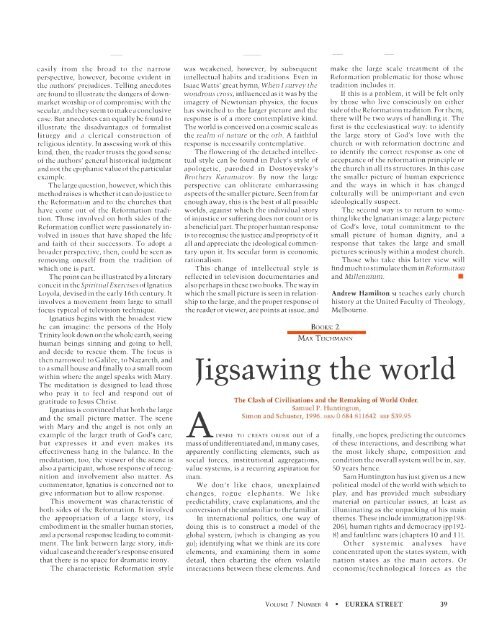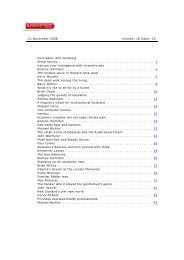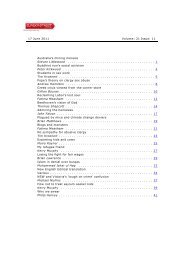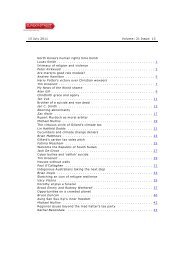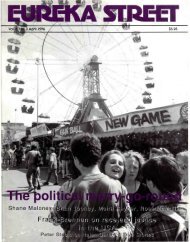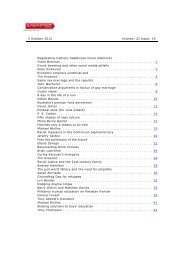n - Eureka Street
n - Eureka Street
n - Eureka Street
You also want an ePaper? Increase the reach of your titles
YUMPU automatically turns print PDFs into web optimized ePapers that Google loves.
easily from the broad to the narrowperspective, however, become evident inthe authors' prejudices. Telling anecdotesare found to illustrate the dangers of downmarketworship or of compromise with thesecular, and they seem to make a conclusivecase. But anecdotes can equally be found toillustrate the disadvantages of formalistliturgy and a clerical construction ofreligious identity. In assessing work of thiskind, then, the reader trusts the good senseof the authors' general historical judgmentand not the epiphanic value of the particularexample.The large question, however, which thismethod raises is whether it can do justice tothe Reformation and to the churches thathave come out of the Reformation tradition.Those involved on both sides of theReformation conflict were passionately involvedin issu es that have shaped the lifeand faith of their successors. T o adopt abroader perspective, then, could be seen asrem oving oneself from the tradition ofwhich one is part.The point can be illustrated by a literaryconceit in the Spiritual Exercises of IgnatiusLoyola, devised in the early 16th century. Itinvolves a movement from large to smallfocus typical of television technique.Ignatius begins with the broadest viewhe can imagine: the persons of the HolyTrinity look down on the whole earth, seeinghuman beings sinning and going to hell,and decide to rescue them. The focus isthen narrowed: to Galilee, to Nazareth, andto a small house and finally to a small roomwithin where the angel speaks with Mary.The m editation is designee\ to lead thosewho pray it to feel and respond out ofgra titude to Jesus Christ.Ignatius is convinced that both the largeand the small picture matter. The scenewith Mary and the angel is not only anexample of the larger truth of God's care,but expresses it and even makes itseffectiveness hang in the balance. In themeditation, too, the viewer of the scene isalso a participant, whose respon se of recognitionand involvement also matter. Ascommentator, Ignatius is concerned not togive information but to allow response.This movement was characteristic ofboth sides of the Reformation. It involvedthe appropriation of a large story, itsembodiment in the smaller human storie ,and a personal response leading to commitment.The link between large story, individualcase and the reader's response ensuredthat there is no space for dramatic irony.The characteristic Reformation stylewas weakened, however, by subsequentintellectual habits and traditions. Even inIsaac Watts' great hymn, When I survey thewondrous era s, influenced as it was by theimagery of N ewtonian physics, the focushas switched to the larger picture and theresponse is of a more contemplative kind.The world is conceived on a cosmic scale asthe realm of nature or the orb. A faithfulresponse is necessarily contemplative.The flowering of the detached intellectualstyle can be found in Paley's style ofapologetic, parodied in Dostoyevsky'sBrothers Karamazov. By now the largeperspective can obliterate embarrassingaspects of the smaller picture. Seen from farenough away, this is the best of all possibleworlds, against which the individual storyof injustice or suffering does not count or isa beneficial part. The proper human responseis to recognise the justice and propriety of itall and appreciate the ideological commentaryupon it. Its secular form is economicrationalism .This change of intellectual style isreflected in television documentaries andalso perhaps in these two books. The way inwhich the small picture is seen in relationshipto the large, and the proper response ofthe reader or viewer, are points at issue, andBooKs: 2M AX T EICHMANNmake the large scale treatment of theReformation problematic for those whosetradition includes it.If this is a problem, it will be felt onlyby those who live consciously on eitherside of the Reformation tradition . For them,there will be two ways of handling it. Thefirst is the ecclesiastical way: to identifythe large story of God's love with thechurch or with reformation doctrine andto identify the correct response as one ofacceptance of the reformation principle orthe church in all its structures. In this casethe smaller picture of human experienceand the ways in which it has changedculturally will be unimportant and evenideologically suspect.The second way is to return to somethinglikethe Ignatian image: a large pictureof God's love, total commitment to thesmall picture of human dignity, and aresponse that takes the large and smallpictures seriously within a modest church.Those who take this latter view willfind much to stimulate them in Reformationand Millennium.•Andrew Hamilton SJ teaches early churchhistory at the United Faculty of Theology,Melbourne.Jigsawing the worldThe Clash of Civilisations and the Remaking of World Order,Samuel P. Huntington,Sim on and Schuster, 1996. ISBN 0 684 811642 RRP $39 .95Amass of undifferentiated and, in many cases,DES I RE TO CREATE ORDER out of a finally, one hopes, predicting the outcomesof these interactions, and describing whatapparently conflicting elem ents, such as the most likely shape, composition andsocial forces, institutional aggregations, condition the overall system will be in, say,value system s, is a recurring aspiration for 50 years hence.man.Sam Huntington has just given us a newWe don' t like ch aos, unexplained political model of the world with which tochanges, rogue e l ephants. W e like play, and has provided much subsidiarypredictability, crave explanations, and the material on particular issues, at least asconversion of the unfamiliar to the familiar. illuminating as the unpacking of his mainIn international politics, one way of them es. These include immigration (pp 198-doing this is to construct a model of the 206); human rights and democracy (pp192-global system, (which is changing as you 8) and faultline wars (chapters 10 and 11 ).go ); identifying what we think are its core Other systemic analyses haveelements, and examining them in some concentrated upon the states system, withdetail, then charting the often volatile nation states as the main actors. Orinteractions between these elements. And economic/technological forces as theV OLUME 7 NUMBER 4 • EUREKA STREET 39


